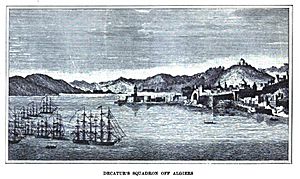Second Barbary War facts for kids
Quick facts for kids Second Barbary War |
|||||||
|---|---|---|---|---|---|---|---|
| Part of the Barbary Wars | |||||||
 Decatur's squadron off Algiers |
|||||||
|
|||||||
| Belligerents | |||||||
| Commanders and leaders | |||||||
| Strength | |||||||
| 3 frigates 3 brigs 2 schooners 2 sloops |
5 frigates 7 smaller warships |
||||||
| Casualties and losses | |||||||
| 40 killed and wounded | 53 killed Many wounded 486 captured 2 ships captured 1 ship sunk |
||||||
The Second Barbary War (1815), also called the U.S.–Algerian War, was a short conflict. It was fought between the United States and some states along the North African coast. These states were Tripoli, Tunis, and Algiers. The war officially ended when the United States Senate approved a peace treaty on December 5, 1815.
However, the ruler of Algiers, called Dey Omar Agha, did not agree with the treaty. He refused the peace terms and even threatened Christians living in Algiers. An American official named William Shaler had helped make the treaty. He later had to leave Algiers during a big attack on the city in 1816. Shaler then worked out a new treaty in 1816. It took a few years for the U.S. Senate to approve this new treaty, which happened on February 11, 1822.
After this war, the United States and European countries stopped paying money to these states. This money, called tribute, was paid to prevent pirates from attacking ships. Stopping these payments helped end piracy in that area. Pirates had been a big problem there for many years. Western nations also built stronger and more advanced ships. The Barbary pirates could not compete with these new ships.
Contents
Why the War Started: The Background
The First Barbary War (1801–1805) had ended with an uneasy peace. But then, the United States focused on a new war with Britain, called the War of 1812. During this time, the Barbary pirates started attacking American merchant ships again. They would capture the ships and their crews. Then, they would demand money from the U.S. government to release them. At the same time, major European countries were busy fighting in the Napoleonic Wars. These wars did not fully end until 1815.
Once the War of 1812 was over, the United States turned its attention back to the pirate problem. On March 3, 1815, the U.S. Congress decided to send naval ships to fight Algiers. A group of ships, led by Commodore Stephen Decatur, sailed on May 20. This group included several warships like the USS Guerriere, Constellation, and others.
The War Begins: Key Battles
After the War of 1812, Algiers had sided with the British. President Madison suggested that Congress declare war on Algiers. Congress did not formally declare war. However, they passed a law on March 3, 1815. This law allowed the president to use the U.S. Navy to protect American ships and sailors. It also allowed the Navy to capture Algerian ships and goods.
On May 20, 1815, ten ships left New York. Commodore Decatur's ships soon found the main Algerian warship, the Meshouda. They captured it in a fight called the Battle off Cape Gata. They also captured another Algerian ship, the brig Estedio, in the Battle off Cape Palos.
By June 29, Decatur's ships reached Algiers. They began talking with the ruler, the Bey. The United States demanded payment and threatened to attack. The Dey finally gave in. He signed a treaty on July 3, 1815, aboard the ship Guerriere. In this treaty, Decatur agreed to return the captured Algerian ships. The Algerians released about 10 American prisoners. In return, the U.S. released about 500 Algerian prisoners. Algiers also paid $10,000 for ships they had seized. The treaty also said the U.S. would never pay tribute again. It also gave the U.S. full shipping rights in the Mediterranean Sea.
What Happened Next: The Aftermath
Sadly, all 10 American prisoners who were freed died. The ship taking them home, the Epervier, sank in the Atlantic Ocean on August 9, 1815. Even though the war was short, it showed that the U.S. was strong. It was a victory for free trade.
In early 1816, Britain sent a group of warships to Tunis, Tripoli, and Algiers. Their goal was to make the rulers stop piracy and free European Christian slaves. The rulers of Tunis and Tripoli agreed easily. But the ruler of Algiers was difficult. The British leader, Admiral Edward Pellew, thought he had made a deal to stop slavery. He returned to England.
However, right after the treaty was signed, Algerian soldiers killed 200 fishermen. These fishermen were from Corsica, Sicily, and Sardinia. They had been under British protection. This event made people in Britain and Europe very angry. Pellew's peace talks were seen as a failure.
So, Pellew was ordered to go back and punish Algiers. He gathered a strong group of ships. On August 27, 1816, after more failed talks, the fleet attacked Algiers. They bombed the city for nine hours. This attack badly damaged many of the Dey's ships and shore defenses. He was forced to accept the peace terms he had refused the day before. Pellew warned that he would keep attacking if the terms were not accepted. The Dey agreed, but Pellew had been bluffing. His ships had already used up all their ammunition.
A new treaty was signed on September 24, 1816. The British Consul and 1,083 other Christian slaves were freed. The U.S. also got its ransom money back.
After the First Barbary War, European nations and the U.S. were busy fighting other wars. But after the Second Barbary War, there was no major European war. This allowed European countries to build up their navies. They could then challenge the Barbary states without distractions. Eventually, France took control of Algiers in 1830 and Tunis in 1881.
More to Explore

